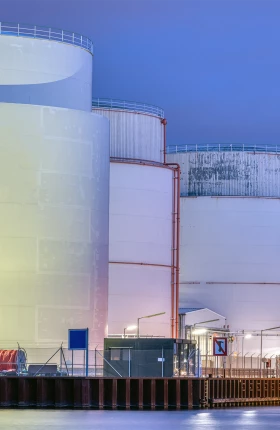Durable carbon dioxide removal (CDR) is necessary to address 6–10 Gtpa residual emissions by 2050 and achieve a net-negative economy in the second half of the century.
Beyond its environmental role, CDR is also beginning to demonstrate potential to generate resilience, growth, and commercial value for businesses. In particular, CDR can do the following:
- Increase revenue in existing businesses. Smallholder farmers in India that work with enhanced rock weathering (ERW) providers have seen ~20%–30% higher yields and ~30% lower fertilizer use, resulting in nearly 20%–25% higher household
incomes.1 1 Based on XPRIZE finalist submissions - Enable market differentiation. Coffee brands that apply biochar to their fields have achieved ~30% price
premiums.2 2 Based on XPRIZE finalist submissions - Offer new business lines. 3M is developing sorbents for direct air capture
(DAC);3 3 Nasdaq, “3M and Svante announce joint development agreement to develop and produce carbon dioxide removal products” Stripe has created a payment feature that streamlines CDRpurchasing;4 4 Stripe, “Stripe launches world’s first large-scale carbon removal purchase tool” Airbus has purchased 400,000 tonnes of carbon removal credits and is selling them to airlines as areseller.5 5 Airbus Carbon Capture Offer - Manage exposure to climate policies. Europe’s Carbon Border Adjustment Mechanism (CBAM) places a carbon price on imports. As a result, Canadian aluminum, which uses hydro-powered smelters to make lower-carbon aluminum, is well-positioned to export to
Europe.6 6 S&P Global, North American aluminum sector blindsided by tariff volatility, trade flow uncertainty While CBAM is still considering the inclusion of CDR, this shift shows how lower carbon inputs and removals can strengthen competitiveness and flexibility under evolving regional policies, including the EU’s Emissions Trading System (ETS) and Japan's GX-ETS.
Fastmarkets, CBAM is coming - can steel and aluminum supply chains bear the costs
The Current Challenge
Corporate demand for CDR could reach 40+ Mtpa by 2030, but the industry delivered only ~0.4 Mt last year, and at high prices that are untenable for many buyers in the voluntary carbon
The XPRIZE Carbon Removal competition was launched to accelerate this transition. Twenty finalists were selected from more than 1,300 participants. Companies submitted detailed strategies and techno-economic models describing the path from today’s kilotonne demonstrations to megatonne commercial plants. This data provides a uniquely granular view into how CDR companies plan to tackle the cost reduction challenge. This report synthesizes finalists’ submissions to extract lessons on how CDR can move from science to commercialization, and what it will take to build megatonne-scale projects and reduce costs to a fraction of today’s levels in only 5–10 years.
CDR Suppliers Consistently Use the Same Five Levers to Drive Scale and Reduce Costs
Despite the technological variety in the finalist cohort, supplier strategies consistently address the challenge of commercialization using the same five levers:
- Scaling increases the size of facilities and components to capture the economies of scale. The lever is most used by technologies that rely on large, centralized facilities such as DAC and direct ocean capture (DOC). Unlocking scaling requires capabilities to manage large capital projects (for example, construction and permitting). The challenge CDR suppliers face is acquiring experience-based capabilities on a rapid startup timeline.
- Modularization is applied by building many repeatable units to gain efficiency through volume and learning. Modularization is often used to produce complex components in DAC and DOC, and also some ocean alkalinity enhancement (OAE) and biochar approaches. Unlocking modularization revolves around aligning on a dominant design early and selecting supply chain and manufacturing partners to spread learning upstream. While modularization is a powerful lever, developing manufacturing capacity for modular components is expensive and high risk for early-stage technologies. Modularity can raise overhead because many small units across multiple sites multiply the work both for deployment (for example, site control, permitting, and interconnection) and for operations (for example,
O&M8 8 Operations and maintenance andMRV9 9 Measurement, reporting, and verification ). - Process optimization and automation rely on adopting proven practices in industrial optimization and manufacturing. While these practices are simple in concept, they have challenged past novel industries such as batteries (for example,
Northvolt10 10 CTVC - Northvolt Charges South ) and EVs (for example, Tesla’s initial Model 3production11 11 Liu et al. - The Rise and Recent Decline of Tesla’s Share of the U.S. Electric Vehicle Market ) and can be expensive to implement. As such, this challenge of process optimization is a pivotal journey in a company’s growth. - Leveraging byproducts centers on monetizing byproducts, intellectual property, and/or services where possible, beyond CDR. As shown by some of the XPRIZE finalists with macroalgae and biochar approaches, these revenues could exceed CDR revenues, allowing companies to subsidize CDR and diversify income sources. The trade-off is increased complexity, as a company that leverages byproducts may operate as both a CDR and a byproducts business.
- Future technology development plays a minor role in the XPRIZE finalist cohort, contributing ~5% of the average projected cost reduction. This does not imply minimal future technical advancement, but rather demonstrates that rapid maturation of CDR is achievable with today’s technology. Further technology advancement provides additional upside.

Application of these levers varies widely. For example, the DAC supplier shown in the figure above emphasizes creating large central plants with scaled balance-of-plant, modularized contactors, and high levels of automation to reduce costs as it matures. In contrast, the biochar supplier focuses primarily on optimizing processes to manage a complex decentralized network of feedstock. Beyond these examples, the chart below illustrates the contribution of each lever to cost reduction across all XPRIZE finalists. CDR has a wide variety of credible pathways to scale that diverge even within common technology pathways. Each pathway has a unique set of capability requirements and risks that CDR players will need to learn to manage.
Stay ahead with BCG insights on climate change and sustainability

CDR Suppliers Also Aim to Control a Common Set of Risks
Beyond the internal levers companies can directly control, CDR players also contend with several external factors that shape both cost and scalability:

- Project financing is challenging for novel, infrastructure-heavy industries such as CDR; however, supplier strategies vary widely, and not all face the same financing constraints. Capital intensity, project size, and use of saleable assets vary by orders of magnitude for different CDR suppliers. This diversity supports multiple financing strategies. Large, capital-heavy DAC plants may leverage a projectized term loan. In contrast, lower capital, decentralized approaches, such as those used by many biochar suppliers, may leverage credit revolvers or offtaker financing. Approaches that use many saleable assets, such as ERW, may utilize asset-backed financing or leaseback structures. Financing CDR is not one-size-fits-all.
- The core supply chain risk arises from dependence on non-commoditized components and feedstocks. Suppliers are reluctant to build new capital-heavy lines for a single novel customer, so these supply chains often have few suppliers, increasing costs and risk. CDR suppliers mitigate supply chain risk by removing bespoke elements from commercial designs, creating close partnerships, or vertically integrating.
- Logistics for transporting feedstock, waste, and CO2 are a primary cost contributor for several XPRIZE finalists. These suppliers are typically distributed or are unable to co-locate with feedstock due to geographic constraints (for example, biochar and macroalgae). To limit these costs, suppliers optimize their footprint, adjust their logistics fleet ownership structure, digitize fleet operations, and share infrastructure with partners.
- Energy is critical for many DAC, OAE, and DOC suppliers. Electricity prices are increasing, becoming more volatile, and diverging more sharply by region. Access to electricity is also becoming increasingly challenging due to slow transmission development and competition from data centers. Suppliers respond by improving energy efficiency, engineering operational flexibility around power markets, diversifying site locations, and building partnerships with energy suppliers.
- Even as labor intensity per tonne falls with automation, absolute headcount requirements rise sharply at megatonne scale. Suppliers typically ensure workforce and skillset availability by clustering in talent hubs, standardizing operations, and building robust training programs.
- Land and water are generally secondary concerns for CDR, but can pose a risk in specific contexts. DAC, OAE, and DOC require industrial land with clean power, interconnection, and zoning, which are in high demand. Biochar and ERW operate across fragmented land owned by farmers, foresters, and miners, requiring complex relationship management. Finally, water availability risk can arise for plants sited in arid regions.
What Does This Mean for Different Players in the CDR Ecosystem?
CDR suppliers can gain a strategic advantage through their execution strategy, rather than relying solely on proprietary technology. However, implementing these strategies is complex and requires companies to develop new internal expertise, such as manufacturing experience; corporate capabilities, such as workforce training programs; and partnerships, such as clean electricity agreements with utilities.
In this new commercialization phase of CDR, large offtakers can take advantage of strategic roles beyond purchasing carbon credits:
- Sustainability teams can consider opportunities to minimize CDR project risks, for example, by providing long-term offtake agreements for CDR or byproducts. They can also provide strategic financing, for example, through upfront CDR purchases, expand the CDR demand base through industry coalitions/offerings such as the Airbus Carbon Capture Offer, or simplify offtake structuring, similar to the Google and LevelTen Energy example in renewables.
- Strategy teams can consider leveraging CDR to differentiate their product and drive a green premium, as some coffee players have successfully done. They can also expand into the new markets created by CDR, similar to what 3M aims for with developing new sorbent technologies.
- Finally, operational teams can pursue different avenues to capture synergies with CDR. They can reduce feedstock requirements, as some agricultural players have done, by using biochar to reduce fertilizer needs. They can also consider sharing infrastructure with CDR players, as some desalination plants have done, by sharing their water management infrastructure with ocean CDR approaches (for example, OAE, DOC). Finally, they can consider the opportunity to minimize environmental risks, as some mining companies have done by using waste mineralization CDR approaches to stabilize mine tailings.
Many CDR technologies can be successfully scaled without further technological or scientific breakthroughs. Investors can structure investments to reflect this more implementation-heavy risk profile, focusing on de-risking construction, supply chain, and operations rather than technology. They can also tailor investment structures to the wide range of CDR approaches exhibited even within common technology pathways. This variability complicates filtering for viable investments but also creates room for financial innovation and diverse investment theses.
Data from the XPRIZE competition provides uniquely granular insights into how the CDR industry will evolve in the next decade. Findings have both environmental and commercial implications for both traditional CDR players and players without an existing connection to the industry. More details are available in the full report here.






